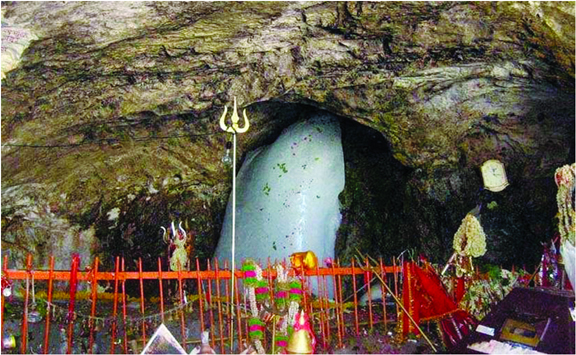
Amarnath Cave is one of the most revered pilgrimage sites among Hindus. Situated at a height of 3,888 m in Jammu and Kashmir, Amarnath Cave is considered one of the holiest shrines of Lord Shiva. Every year thousands of devotees undertake the Amarnath Yatra, which is organized by Shri AmarnathJi Shrine Board. Formed due to the melting of ice from the roof of the cave to the floor, Amarnath Cave contains Shivling that people from all across the country visit to seek blessings from Lord Shiva.
Significance of Amarnath Temple
As you already know there is a block of ice formed Shivling inside the Amarnath Cave. On one hand, science says that it has been formed due to the dripping of ice from the roof of the cave, the Hindus believe that it is the presence of Lord Shiva in the form of a Lingam. Not only this but it is also believed that this Lingam expands and contracts according to the phases of the moon. Though, there is no scientific proof till now. Along with Shivling, you can also witness two other ice formations which are said to be of Goddess Parvati and Lord Ganesha.
Amarnath Temple History
It is said that there was a shepherd named Buta Malik who first discovered the cave. However, there is a mention of Amarnath Temple (Amareshwar) in the book “Rajatarangini” and people believe that Queen Suryamathi gave a present of Trishul, banalingas, and sacred emblems to Amarnath Temple back in the 11th century AD. And when in the 15th century, Buta Malik rediscovered the cave, the story of Quess Suryamthi was disremembered.
With that being said, Buta Malik received a bag full of coal from a saint and when he got back home, he was surprised to see gold coins instead of coal. He was grateful but overwhelmed. And to say thank you to the saint he went back to the place where he met him but found the cave with Shivling inside instead. This led to the discovery of Amarnath Cave. From then onwards, it became a major place for pilgrimage among Hindus.
There are some other epics that tell a different story. It says that the valley of Kashmir was underwater and Kashyap Rishi drained it through various rivers and rivulets. During the same timeline, Bhrigu Rishi visited the Himalayas and was the first to have the darshan of the holy Amarnath Cave. When villagers heard about this, it quickly became Shiva’s abode and a center of pilgrimage. Since then, a large number of devotees undertook the Amarnath Yatra through rugged terrain to seek eternal happiness.
Amarnath Temple Story
Many tourists who visit Amarnath Temple wonder what is the mythology behind Amarnath Cave? Well, as per a Hindu legend, it is believed that when Parvati asked Shiva the secret of life and eternity. At first, he refused but she insisted, so he decided to reveal the secret to her.
He left Mount Kailash along with Goddess Parvati and left his belongings at various places. For instance, Nandi, the Bull at Pahalgam, Moon from hair at Chandanwari, and snakes on the banks of Lake Sheshnag. Lord Ganesha was left at Mahagunas Parvat also called Mahaganesh Mountain.
Plus, the five elements of nature – Earth, Water, Air, Fire, and Sky were left at Panchtarni. As he sacrificed his belongings, he performed the Tandava Dance. And later, enter the cave with Parvati. To ensure no one was listening, he created fire to demolish all the life around him. But a pigeon under Lord Shiva remained and heard the secret of immortality.
They were born and even today, devotees who visit Amarnath Temple can see a pair of pigeons inside the cave nesting. And because the secret of immortality was told here by Lord Shiva, the cave was called Amarnath.
Shiva followers thus, take the Amarnath Yatra with true hearts and feelings and present to Lord Shivain hope of a righteous living, health, prosperity, and purity of the sins. Families, friends, and companions are often seen traveling together to Amarnath Temple in Jammu and Kashmir despite it being 36 to 48 km long and difficult to enlighten themselves by Shiva’s true light. Amarnath Yatra is organized every year but in 2022, it will be starting on 30 June and will end on 11 August due to Sawan Purnima. There are 2 routes – Pahalgam and Baltal you can choose to go on. This can be covered in 4 to 5 days (Pahalgam) or 2 to 3 days (Baltal). Most devotees prefer the longer and more traditional route from Srinagar though. Elderly citizens can choose to ride on a horse too.
Source: TourismOfIndia





Be the first to comment